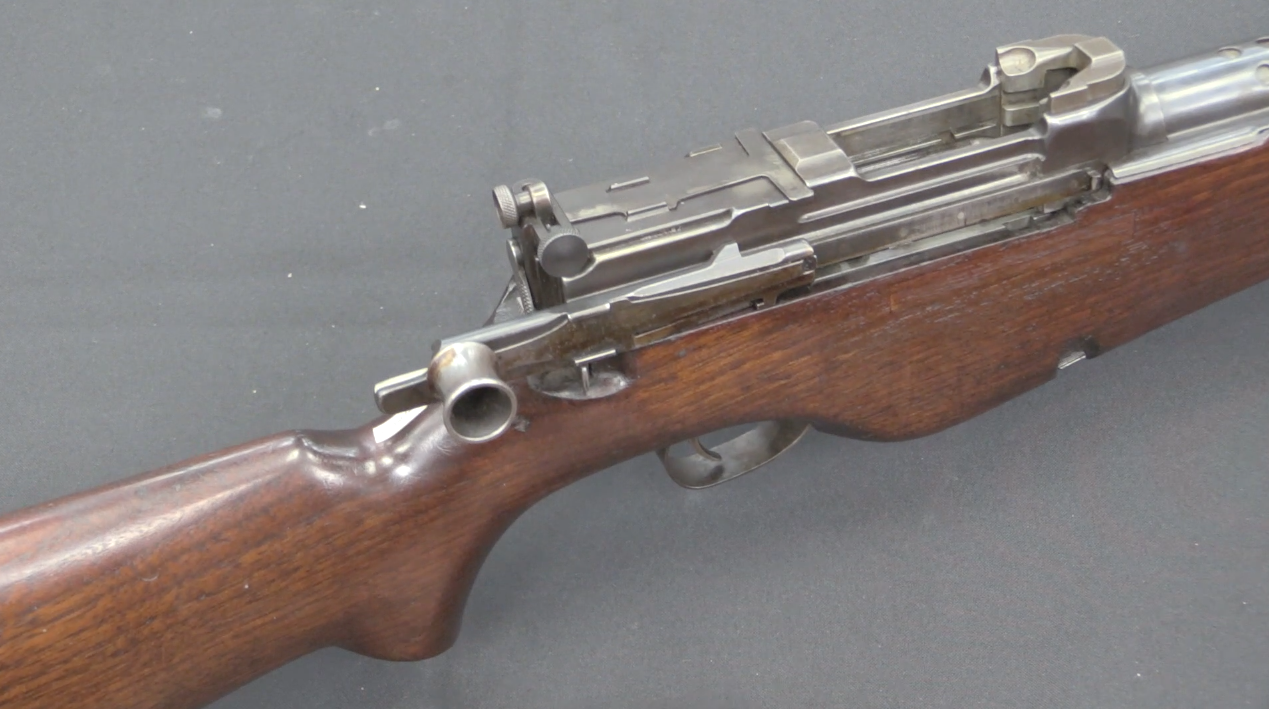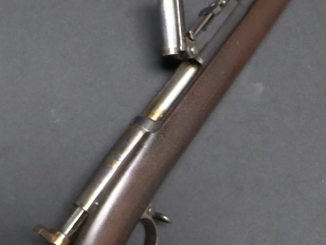The M1C was an M1 Garand with a telescopic sight, using a mounting system developed by the Griffin & Howe company of New York. It utilized a rail pinned and screwed to the left side of the receiver, coupled with a quick-release scope on top. The rails had to be installed prior to heat treating the receivers, which had the unfortunately consequence of preventing rifles form being chosen for sniper conversion based on their mechanical accuracy. Instead, accuracy would be tested only after rifles were complete, leading to a 60% rejection rate.
The scope was offset to the left of the receiver so as not to interfere with the Garand’s clip loading, and issued with a leather cheek pad to give the shooter’s cheek weld a matching offset to the left. The scope used with the M1C was the M73B1, later replaced with the M81 and M82 scopes – all military versions of the 2.5x Lyman Alaskan hunting scope (which was a very good piece of equipment despite its low magnification)
The M1C was adopted in 1944, but production and quality control delays would prevent it from seeing any action in WWII. It was in use during the Korean War, however, before being replaced by the M1D.




CMP currently has a bunch of M1C and M1D rifles availabile.
Since these were being made during the height of a major war, it’s interesting that so much concern was being made to production quality, rather than just shipping them out as-is with the scope mounting rails being skewed at various angles (and thus forcing each scope to be zeroed individually and perhaps drastically to match the rifle)
As “sniper” versions of various common battle rifles tend to command a very premium price, it’s got to be a counterfeiter’s dream for making easy money essentially just by slapping on a scope and hoping the buyer won’t notice the small esoteric differences.
The scoped ’03 Springfield rifles were already in the field, and it would not have made much sense to have displaced that ongoing supply of rifles with a rifle that had serious accuracy problems.
I have a funny story about “fakes” … had a person come into the shop with a sniper’s rifle that had been bought by the soldier and taken home after their service. The problem was, it wasn’t “correct.” It had details about it that didn’t match up with what all the books said should or shouldn’t be there on a “real” one. So, the obvious question, could we “correct” the rifle so it fit the norm. ^__^
Personally, I would never buy any of these “rare” service rifle variants unless I could speak directly with the soldier that brought it out of service. Otherwise, all you’re buying is something that’s “correct” … there’s no way to determine if it is or isn’t “authentic.”
Great series of sniper videos Ian. It does put into perspective the efforts of some of the other countries involved in WW2, the Russians milling scope rails in to hundreds of thousands of SVT-40’s etc. Also the PU scope is looking better in context. Are there upcoming videos on other nations early 20th century sniper rifles coming up?
You should read my article “Was the Fix In?” that appeared in the Spring 2013 Garand Collectors Assn Journal.
As to faking them, many have tried, but 40 years of research have identified the serial blocks of all M1Cs, and we can tell if it’s fake. It’s a free service to GCA members.
That’s great to know – thanks!
These rifles have had long service histories that have resulted in many changes in configuration over their service life. Sadly, all of this is being lost when collectors “restore” these service rifles. And they always seem to “restore” them to their most valuable, (read “rare”), configuration.
Did the Army consider going with a long eye relief scope that would have allowed for regular clip loading while placing the scope above the bore? Sort of like a Mauser ZF-41. Too radical of a concept for the time?
Too radical, as most scopes used by the US Army didn’t have much eye relief. Why make a sudden change? Nobody had the time to train on a new scope placed halfway across the weapon… Or am I wrong?
The Zf-41 was designed and manufactured by Carl Zeiss. As far as I know, Mauser had nothing to do with it.
I meant the ZF-21 that went on top of the Mauser; did not mean to imply that Mauser had manufactured the scopes themselves.
You mention in your video that some commercial lyman alaskan scopes were used early on. Does anyone have actual evidence that this was done? Many commercial lyman alaskans that are offered for sale make some reference to being a “sniper scope” which I believe is misleading. Every M81 or M82 scope I have seen has some distinct differences from the commercial scopes I have seen other than just the sunshade and the rubber eye piece. That is the rectangular blocks on which the adjustment knobs are mounted on the commercial scopes are more finished with the corners being rounded without the sharper edges found on the M81 & M82 scopes as shown in your video. This is the way they were manufactured does not appear to be related to wear. Also my commercial scope has “ALL WEATHER” roll marked on the side of the blocks, while my M82 scope has the scope serial number in its place.
I think this was a very good presentation. I was ripped off by a fake and know the problems. WOULD IT BE POSSIBLE TO RUN A SEGMENT ON IDENTIFING FAKE M1C’s AND M1D’s.
It is interesting to remember that the Japanese added scopes after their rifles were test fired. No sane manufacturer should designate a receiver for sniper use before the testing is done. This applies to infantry rifles, not specialized rifles, which would have their own production line. Or am I wrong?
The initial scope approved for the M1C was the M73, which was to be a variation of the Lyman Alaskan (not the M73B1 as stated in the opening article). A number of Lyman Alaskans with “B” prefix serial numbers came out of military surplus in the 1970s or 80s, and many people believe those were the first ones used on the M1C and possibly the M1903A4s as substitute for the then standard M73B1, prior to adoption of the M81 and M82 which were modifications of the Alaskan.
Dave McClain (see above) is to be commended for his diligent research and sharing of info on M1C serial number blocks.